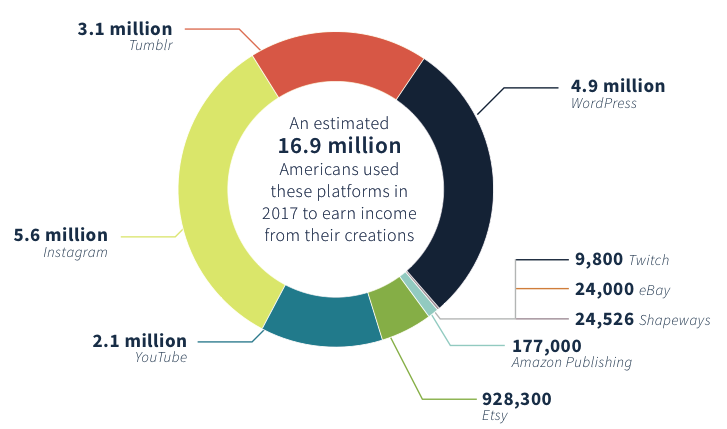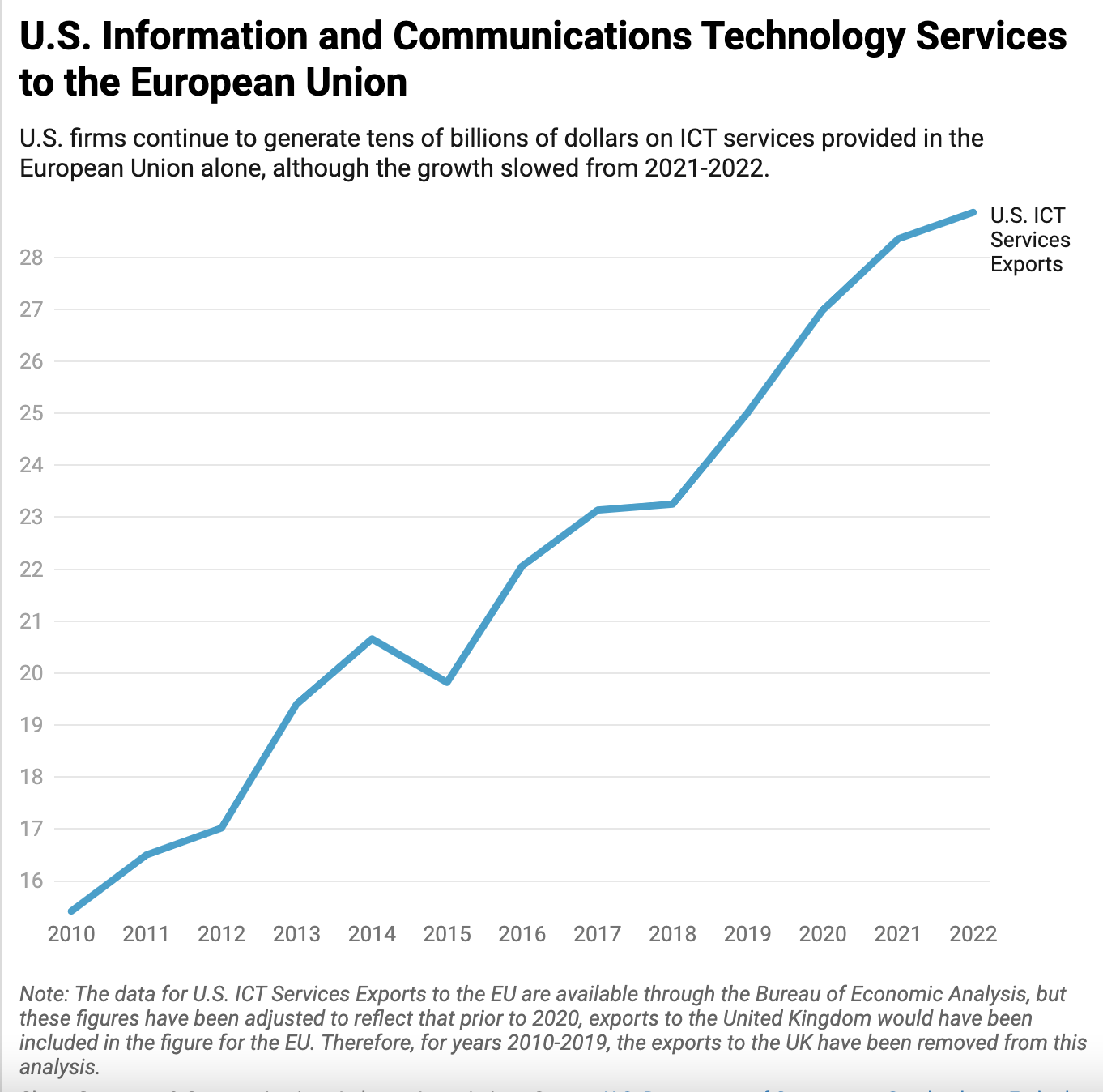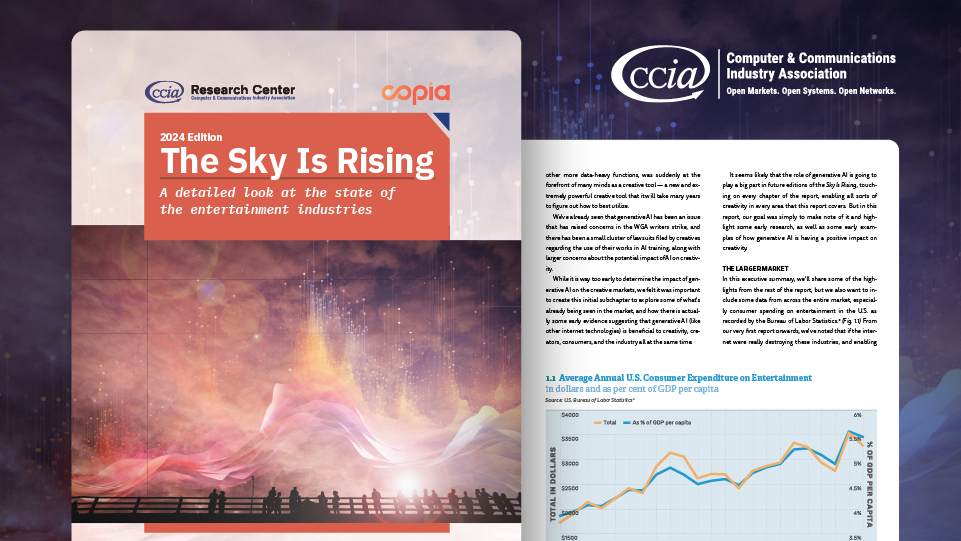Sizing Up the Creator Economy
The Internet has empowered creators—writers, musicians, filmmakers, and other content creators—to showcase their creativity. The “disintermediation” of traditional publishing houses and record label companies due to the digital distribution model is old news. But how much have independent creators tangibly benefited from the digital economy? A recent case study by the Re:Create Coalition of nine platforms that are popular among creators—Amazon Publishing, eBay, Etsy, Instagram, Shapeways, Tumblr, Twitch, WordPress, and YouTube—suggests that 16.9 million creators in the U.S. earned an estimated $6.8 billion on these platforms in 2017.
Online Creativity Drives the Economy
Earlier this year, Re:Create released its report titled The Growth of America’s New Creative Economy, which undertook the ambitious initiative of quantifying how much income creators earned on the Internet on nine digital platforms in 2017. In updating the report from 2016 to 2017, the authors, Professor Robert Shapiro from Georgetown University McDonough School of Business and Siddhartha Aneja from Sonecon, demonstrated that the creator economy grew at a robust rate in 2017.
Creators earn income in a variety of ways, most commonly by sharing advertising revenues with the platform; Instagram, YouTube, and Tumblr are notable examples. How much creators make usually depends on viewer traffic—the number of views or click-throughs of the ads placed near the creator’s content. Some creators may charge a fixed fee to display an ad or link to an advertiser’s website.
Subscriptions and brand sponsorships are another way creators earn income. On Twitch and Patreon, creators earn revenue from the monthly subscription fees paid by their followers, as well as sponsored ads, and pay a commission fee to the platform. With Patreon, in particular, creators can create multiple “tiers” to which customers can subscribe for varying levels of “benefits” at differentiated prices. On Instagram and YouTube, creators can earn income as influencers who are paid fees to promote a brand or by partnering with brands to promote products in their blog or video posts for commissions. Creators with large followings on Instagram, for instance, earn additional revenue offline by organizing or participating in in-person events.
Finally, there is the direct sales model. On platforms such as Etsy, Amazon Publishing, and Shapeways, creators have a revenue-sharing arrangement for direct sales of items they post on those platforms. Creators frequently offer their content on multiple platforms and earn income in multiple ways.
According to this year’s Re:Create study, nearly 17 million American creators earned incomes from posting their personal creations on the nine platforms in 2017. Collectively, these creators earned $6.8 billion that year. Compared to 2016, the number of income-earning creators across the nine platforms increased by 16.6% or 2.4 million creators; and the revenue earned increased by 17% or $1 billion. Among the platforms in the study, Instagram, WordPress, Tumblr, and YouTube enjoyed the greatest growth in the number of income-earning creators in 2017.
The Number of Creators Earning Income in New Creative Economy in 2017
Source: Taking Root: The Growth of America’s New Creative Economy, Re:Create Coalition (2019) at 2, https://www.recreatecoalition.org/wp-content/uploads/2019/02/ReCreate-2017-New-Creative-Economy-Study.pdf.
The revenue calculations in the report are likely rough estimates—given that the authors pool data from a variety of publicly available sources and use the distribution from a proxy dataset to map out the distribution of revenue among the creators. If anything, Re:Create’s creator-earned revenue numbers are likely a conservative estimate because the report only covers nine platforms that represent one prominent piece of the creator economy.
In addition to the Re:Create study, the Computer and Communications Industry Association (CCIA) and the Copia Institute also published an updated version of the Sky Is Rising report this year, highlighting the growth in the creative industry. The report examines trends in the creative industry by type of content—namely music, books, videos, and video games—and covers a wide breadth of digital platforms. The aggregate stats for each industry demonstrate that content providers are gaining new customers at an increasing speed. Global gaming video content revenue, for instance, grew from $4.4 billion in 2016 to $5.2 billion in 2018. The report’s findings, in conjunction with the Re:Create study, underscore how individual creators are increasingly pushing out content.
Start-ups and investors who are capitalizing on the growing market of creators and social media influencers may further fuel independent content creation. Patreon, which initially began as a crowdfunding platform for musicians to connect with their fan bases, has since shifted its business model to provide a Software as a Service (SaaS) platform with a suite of tools for creators. In May 2019, Streamlabs also launched Creator Sites, a creator-focused website builder to help livestreamers consolidate their online brands. Some venture capital funds have shown interest too: Next 10, a $50 million venture capital fund based in Los Angeles, launched an incubator specifically to support YouTube creators. The program, launched in 2018, plans to seed 25 to 40 “emerging video creators” to focus on creating educational video content targeting children and young adults. The interest in creators and innovative tools that cater to this community could motivate more content creators to join in.
Competition Across Platforms for Content Makers
Not all platforms covered in the Re:Create study enjoyed growth in creator-earned income in 2017. One exception was WordPress, which saw a significant decline of 20.8% in creator-earned income. This trend was not attributable to a general trend in the blogging industry. According to Quantcast, there was no drop in the aggregate number of bloggers or the number of bloggers earning income through blogging on the top 11 blogging platforms that year. Rather, strong competitors to WordPress emerged, reducing the platform’s share of blogging traffic. For example, Tumblr’s traffic grew 22.6% in 2017, raising Tumblr’s market share among the 11 largest blogging platforms from 22% to 26%.
In the livestreaming space, Twitch saw an upshot—a 58.8% increase in the number of creators in 2017. Two years later, Google decided to shut down YouTube Gaming. Google created YouTube Gaming as a standalone YouTube service to focus solely on gaming and compete with Twitch, a year after Amazon acquired Twitch in 2014. In comparing the 2016 and 2017 figures, the drastic change in revenue earned by creators on each platform in a one-year span suggests that creators’ preferences for platforms can change within a relatively short window.
Firms cannot be too complacent that content makers will always operate on their platforms, however. As David Evans and Richard Schmalensee explain in their book Matchmakers, multi-sided platforms face a unique challenge of having to serve multiple groups with distinct needs. A “matchmaker,” like Twitch or Patreon, is only as good as its ability to attract both creators and viewers. If one party does not show up, the platform is likely to lose the other party too, hence resulting in a “coordination problem.” A related issue is that multi-sided platforms need critical mass to be a compelling product. A matchmaker not only needs all parties to show up but enough on all sides to show up. (To learn more, read DisCo’s Q&A session with Professor Schmalensee about multi-sided platforms.) This is to say, the creator-focused multi-sided platforms will have to continue innovating to engage and retain both creators and consumers.
The growth in the American creative economy is yet another example of how the Internet has driven innovation and entrepreneurship. The studies cited earlier in this post shed light on this development. Further technological developments that provide more advanced platforms will continue to expand venues for creators to disseminate and commercialize their works.








